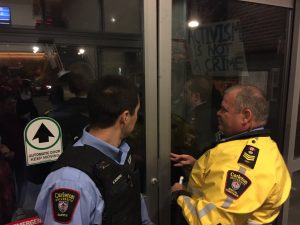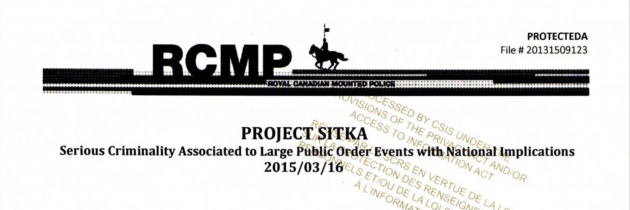SITKA raises curtain on RCMP surveillance of indigenous activists
Carleton researchers Jeffrey Monaghan and Andrew Crosby say they found Project SITKA almost by accident as part of a wider search for government documents that illustrate surveillance techniques. After filing one of their many routine access to information requests, they found a 2015 RCMP report listing 89 indigenous rights activists who were closely profiled and monitored by the police.
Created by the RCMP’s National Intelligence Coordination Centre in 2014, the database originally contained 313 individuals. Those were grassroots indigenous activists. Many were deemed “passive,” and were dropped from active consideration, the report says.
According to the report, the 89 who showed potential for “criminality” were further scrutinized and added to a database to be shared with front line officers and industry partners.
Monaghan, a criminology professor at Carleton, said that this report is part of a long history of indigenous people in Canada being placed under far more scrutiny than other people.
“SITKA is notable because its scope is not just the really prominent actors,” said Monaghan. “It shows us how much information’s being accumulated, and stored.”
Monaghan’s research partner, Crosby, said the 89 individuals under surveillance are unaware of it, and therefore have no recourse to challenge the activity.
While names are redacted from the report, it breaks down where the scrutinized activists are from. The majority, 35, are from New Brunswick, but 15 are from Ontario.
Metis activisit Gabrielle Fayant said she found only one thing notable about the report: they now had proof of surveillance. “People have been watching indigenous people very closely for a very long time,” said Fayant, who is from Alberta. But now, she says, “It was laid out in a report, ‘we’re watching you’.”

Gabrielle Fayant (left) participating in an Idle No More protest on Parliament Hill. (Photo Gabrielle Favant/Instagram)
The Metis woman calls herself “oskapewis”, which means “helper” in Assiniboine. She helps when she is needed. An active indigenous rights protector since the round dances of Idle No More in 2013, Fayant believes that she has been watched for her activism in the past.
The report names dozens of indigenous groups of particular concern including Unis’ot’en Camp in British Columbia and Idle No More. Fayant says she has been involved with all of them. She’s confident that of the 313 people on the original list, she knows over half of them.
But Fayant is optimistic: “Being under surveillance, in many cases, means that you’re doing something good.” The tension between state surveillance and indigenous activists is ongoing.
A week after the Project SITKA report was released, Carleton coincidentally held a lecture on campus called “Infrastructure Security and Resilience.” According to the agenda, the evening’s speakers were to include a former Assistant Deputy Director for CSIS, as well as the COO for a major North American energy regulatory authority.
The night’s facilitator, Martin Rudner, said that the lecture’s speakers were looking at the critical infrastructure needed for Canada’s security.
Carleton student and activist Ashley Courchene said he was incensed by a security industry presence on campus and quickly took to Facebook to gather a group of similarly concerned people. After a quick briefing session, the group set about shutting down the lecture.
Courchene said the group was “protesting the criminalisation of indigenous people,” reasoning that when industry and government talk of “protecting the critical infrastructure,” it can often be in opposition to indigenous peoples.

Security guards block protesters from entering Richcraft Hall during last Tuesday’s protest. (Photo: Ruth Yohanes-Tecle)
Crosby was not at the protest, but commented later that organizations concerned with National Security, like CSIS, have reframed their role as protecting infrastructure from domestic extremists and terrorism. He says this leads to the troubling association of “indigenous activism” with “terrorism.”
After a conveniently timed fire alarm, protesters were successful in shutting down the lecture series.
Rudner said that he was disappointed that the protesters did not attend the lecture and ask questions rather than shutting it down.
“It was an outrageous violation of the right of academics, professors and others, to have an open discourse on issues of national security,” said Rudner.
The refrain from the activists and academics in the wake of Project SITKA, is that surveillance will not put a stop to their activism.
“My parents have been watched,” said Courchene, who is Anishnaabe from Sagkeeng First Nation, “so I’m carrying that on if I am.” He added somberly, “I’m not scared.”
Fayant draws strength from the veteran activists who mentored her during Idle No More. Surveillance is part of life for them. Fayant keeps their message in mind as she reads Project SITKA: “If you want to watch, then watch. But we’re not doing anything wrong.”
Read the entire report below:

